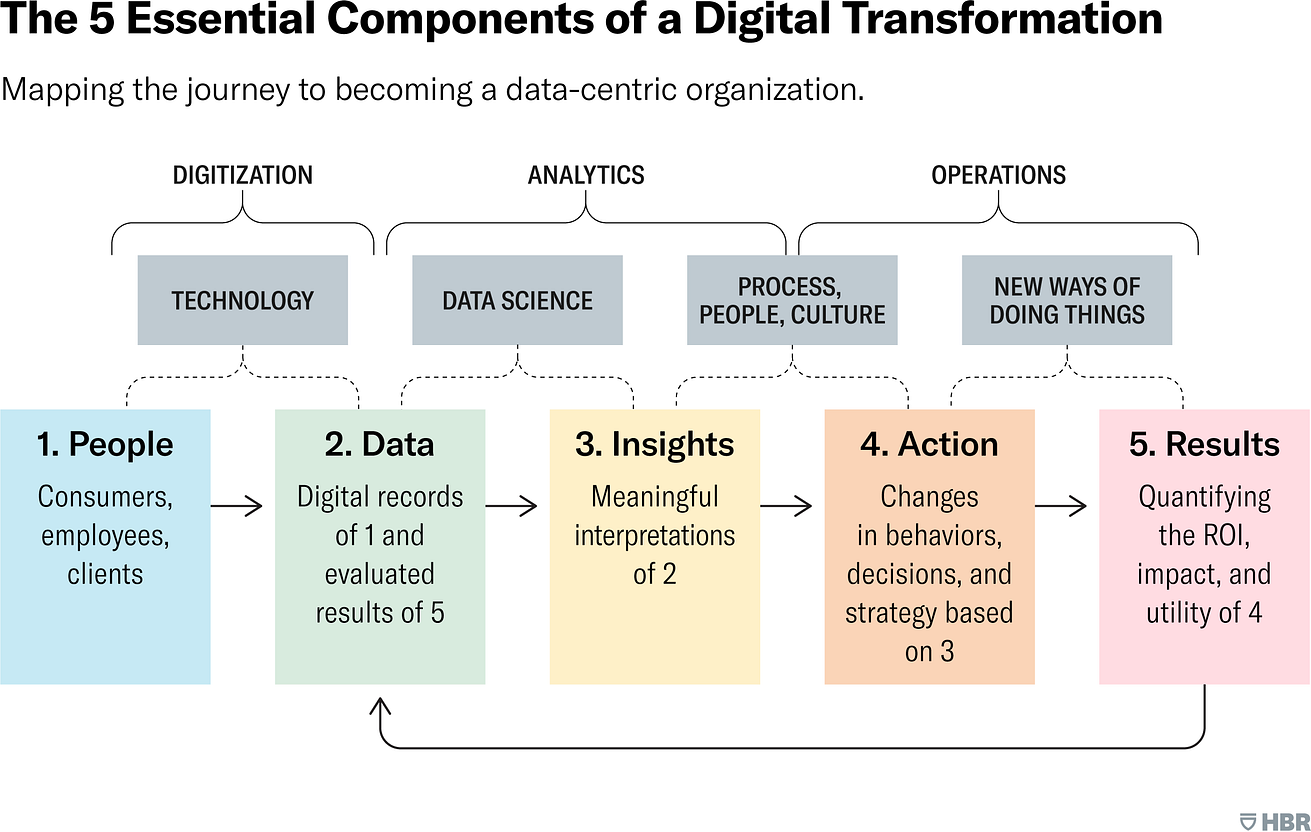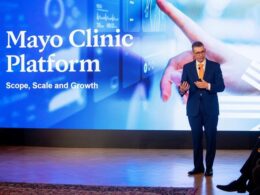This is a republication of the article “The Essential Components of Digital Transformation”, published by HBR, with the title above, and preceded by an Executive Summary.
Site editor:
Joaquim Cardoso MSc.
Health Transformation — institute for research and strategy
October 7, 2022
Harvard Business Review
by Tomas Chamorro-Premuzic
November 23, 2021
Executive Summary (by the editor of the site):
What is the impact of the digital revolution?
The digital revolution forced every organization to reinvent itself, or at least rethink how it goes about doing business.
- Most large companies have invested substantial cash in what is generally labelled “digital transformation.”
- While those investments are projected to top $6.8 trillion by 2023, they’re often made without seeing clear benefits or ROI.
Why many companies are not creating value with digital transformation?
- Common errors include the naïve assumption that by simply buying technology — or investing in any of the fancy tools or shiny new objects of the booming tech market — organizations will somehow transform.
- A major reason for the lack of productivity gains from new technologies, including AI, is the failure to invest in skills — especially the lack of reskilling and upskilling once employees are in your workforce.
What is the fundamental meaning of transformation?
It’s problematic when companies decide to embark on a digital transformation agenda without having a clear definition, let alone vision, for what it means.
- The fundamental meaning of transformation is not about replacing old technologies with new ones, or capturing high volumes of data, or hiring an army of data scientists, or trying to copy some of the things Google or Amazon do.
- The essence of digital transformation is to become a data-driven organization, ensuring that key decisions, actions, and processes are strongly influenced by data-driven insights, rather than by human intuition.
- In other words, you will only transform when you have managed to change how people behave, and how things are done in your organization.
What are the components of a digital transformation?
As the figure below shows, five components are needed to execute an organization’s digital transformation:

What is the critical part of digital transformation?
In short, the critical part of digital transformation is not “digital” but “transformation.”
- Our world has changed dramatically in the past two decades, and adapting your organization to these changes cannot be achieved overnight, or simply by buying new technologies, or collecting more data.
- What is needed is a shift in mindset, culture, and talent, including upskilling and reskilling your workforce so that they are future-ready.
- Leadership is always an argument with the past, with tradition — it is the essential task of leaders to create a bridge between the past and the future, and in that sense digital transformation is not an exception to the rule, but the name we give to today’s bridge.
ORIGINAL PUBLICATION (full version)

The Essential Components of Digital Transformation
Harvard Business Review
by Tomas Chamorro-Premuzic
November 23, 2021
The digital revolution forced every organization to reinvent itself, or at least rethink how it goes about doing business.
Most large companies have invested substantial cash in what is generally labelled “digital transformation.” While those investments are projected to top $6.8 trillion by 2023, they’re often made without seeing clear benefits or ROI.
Most large companies have invested substantial cash in what is generally labelled “digital transformation.”
While those investments are projected to top $6.8 trillion by 2023, they’re often made without seeing clear benefits or ROI.
Although these failures have multiple causes, they are generally the result of underestimating the various steps or stages required to successfully execute a transformation agenda.
For example, common errors include the naïve assumption that by simply buying technology — or investing in any of the fancy tools or shiny new objects of the booming tech market — organizations will somehow transform.
… common errors include the naïve assumption that by simply buying technology — or investing in any of the fancy tools or shiny new objects of the booming tech market — organizations will somehow transform.
But even the best technology will go to waste if you don’t have the right processes, culture, or talent in place to take advantage of it.
As Stanford’s Erik Brynjolfsson noted, a major reason for the lack of productivity gains from new technologies, including AI, is the failure to invest in skills — especially the lack of reskilling and upskilling once employees are in your workforce.
I once managed to persuade my grandfather to buy a cellphone; he never even bothered to take it out of the box. For many organizations, persuading experienced employees or senior managers to deploy new tech tools is a rather similar experience.
… a major reason for the lack of productivity gains from new technologies, including AI, is the failure to invest in skills — especially the lack of reskilling and upskilling once employees are in your workforce.

It’s problematic when companies decide to embark on a digital transformation agenda without having a clear definition, let alone vision, for what it means.
Although every organization is unique, and there are salient differences between types of businesses, industries, and cultures, the fundamental meaning of transformation is not about replacing old technologies with new ones, or capturing high volumes of data, or hiring an army of data scientists, or trying to copy some of the things Google or Amazon do.
In fact, the essence of digital transformation is to become a data-driven organization, ensuring that key decisions, actions, and processes are strongly influenced by data-driven insights, rather than by human intuition.
… the fundamental meaning of transformation is not about replacing old technologies with new ones, or capturing high volumes of data, or hiring an army of data scientists, or trying to copy some of the things Google or Amazon do …
… the essence of digital transformation is to become a data-driven organization, ensuring that key decisions, actions, and processes are strongly influenced by data-driven insights, rather than by human intuition.
In other words, you will only transform when you have managed to change how people behave, and how things are done in your organization.
In other words, you will only transform when you have managed to change how people behave, and how things are done in your organization.
As the figure below shows, five components are needed to execute an organization’s digital transformation:

- 1.People
- 2.Data
- 3.Insights
- 4.Action
- 5.Results
1. People
Digital transformation starts with people, which is a useful reminder that whenever we talk about data — especially valuable data — there are humans at the end of it.
For most organizations, the people aspect of transformation refers to the access they have to consumers, clients, and employees.
Historically, these relationships yielded poor or dispersed records.
Think about analog and informal small businesses, such as a stand in a Turkish bazaar: the salespeople have a great deal of access to, and knowledge of, their customers and clients, but it’s all “trapped” in their minds. In the same way, a London cab driver or a Parisian bistro waiter might have in-depth knowledge of their customers and what they want, or a small business founder might know the 20 employees that make up her workforce rather well, without needing much tech or data.
But what happens when an organization becomes too large or complex to know your customers or employees on a personal basis?

2. Data
If you want to scale the knowledge you have about your customers and employees, and replicate it across a big organization and in far more complex and unpredictable situations, you need to have data — widely accessible and retrievable records of interactions with consumers, employees, and clients.
This is where technology can have the biggest impact — in the process of capturing or creating digital records of people (e.g., what they do, who they are, what they prefer, etc.).
We call this “digitization,” or the process of datafying human behavior, translating it into standardized signals (0s and 1s).
It is useful to remember this, because the real benefits from technology are not “hard” (i.e., cheaper systems or infrastructure), but “soft” (i.e., capturing valuable data).

3. Insights
Although data has been hailed as the new oil, just like with oil, the value depends on whether we can clean it, refine it, and use it to fuel something impactful. Without a model, a system, a framework, or reliable data science, any data will be useless, just like 0s and 1s.
But with the right expertise and tools, data can be turned into insights.
This is where technology gives way to analytics — the science that helps us give meaning to the data. To the degree that we have meaningful insights, a story, a notion of what may be going on and why, or a model, we will be able to test this model through a prediction.
The point here is not to be right, but to find better ways of being wrong. All models are wrong to some degree, but some are more useful than others.

4. Action
But even getting to the insights stage is not enough. As a matter of fact, the most interesting, captivating, and curious insights will go to waste without a solid plan to turn them into actions.
As Ajay Agrawal and colleagues argue, even with the best AI, data science, and analytics, it is up to us humans to work out what to do with a prediction.
Suppose that your insights tell you that a certain type of leader is more likely to derail — how will you change your internal hiring and development process?
Or what if it tells you that customers dislike a certain product — how will this influence your product development and marketing strategy?
And suppose that you can predict if some clients are at risk of going to your competitors, what will you do?
AI can make predictions, and data can give us insights, but the “so what” part requires actions, and these actions need the relevant skills, processes, and change management.
This is why talent plays such a critical role in unlocking (or indeed blocking) your digital transformation.

5. Results
In the final stage of the process, you can evaluate results or impact. Except this is not really the final step — after you evaluate results, you need to go back to the data.
The results themselves become part of the new, richer, dataset, which will be augmented and improved with the findings of the process.
In this iterative process or retroactive feedback loop, you enable your insights to become more predictive, more meaningful, and more valuable, which itself gives more value to the data. And in that process, you enhance and develop the people skills that are needed to produce a great synergy between humans and technology.

In short, the critical part of digital transformation is not “digital” but “transformation.”
Our world has changed dramatically in the past two decades, and adapting your organization to these changes cannot be achieved overnight, or simply by buying new technologies, or collecting more data. What is needed is a shift in mindset, culture, and talent, including upskilling and reskilling your workforce so that they are future-ready. That said, there is one thing that hasn’t changed — namely the fact that all of this is just the new version of an old task or challenge every leader has always faced throughout human history: to prepare their teams and organizations for the future, and create a better future. Nobody is truly a leader if they are in charge and keep things as they are. Leadership is always an argument with the past, with tradition — it is the essential task of leaders to create a bridge between the past and the future, and in that sense digital transformation is not an exception to the rule, but the name we give to today’s bridge.
Originally published at https://hbr.org on November 23, 2021.
About the author
Chief Talent Scientist at Manpower Group, co-founder of Deeper Signals and Metaprofiling, and Professor of Business Psychology at University College London and Columbia University.












